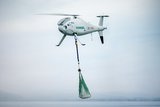PAS 2011: Northrop Grumman expects Block 30 Global Hawk IOC soon
Northrop Grumman expects the US Air Force to declare initial operational capability (IOC) with the Block 30 aircraft in the next couple of months, despite issues highlighted by the initial operational test and evaluation (IOT&E) report released last month.
Defending the performance of the aircraft at the Paris Air Show Ed Walby, Northrop Grumman's Director Global Hawk Business Development, said that many of the issues identified in IOT&E had already been identified by the company and the customer and remedies put in place.
In the assessment Global Hawk flew 19 sorties in 41 days (IOT&E) with only a 57% mission effectiveness. There were issues both with the sensors and the reliability of the airframe.
However, Walby said that Northrop Grumman had progressed beyond the design point at which the aircraft was frozen for OT&E. Looking at an example he said that the generator oil pump issue identified in the report was history. ‘We have that fix understood and we had began testing on that but we hadn't finished endurance testing on it when we entered IOT&E,' he stated.
Contrasting the evaluation with current operations, Walby said that the aircraft was performing well. The Block 30 Global Hawk has been called upon to support a number of recent missions, including the disaster relief in Japan and the ongoing operations in Libya. In real operations the Block 30 Global Hawk has flown 114 sorties in 45 with a much more respectable 92.1% mission effectiveness according to the company.
At the same time as delivering to the USAF customer Northrop Grumman is continuing to expand the capabilities of the aircraft. In conjunction with the Defense Advance Research Projects Agency the company plans to demonstrate an unmanned air-to-air refuelling capability by the end of the year as part of the KQ-X project.
International interest in the Global Hawk, particularly as the capabilities of the Block 30 are demonstrated, also continues to be strong according to Walby. A number of countries including Japan, South Korea, Singapore, Canada, the UK and Australia all continue to keep an eye on the project although given the maritime nature of some of the countries Walby said they may prefer a system more closely resembling the US Navy's Broad Area Maritime Surveillance system.
More from Uncrewed Vehicles
-
Jammer resistant drone designs spark search for countermeasures
The Russia-Ukraine conflict has driven another stage of evolution for drones and the counter measures to defend against them.
-
![L3Harris launches Amorphous software for control of uncrewed platforms]()
L3Harris launches Amorphous software for control of uncrewed platforms
The new Amorphous software is a universal controller that would allow a single operator to control a swarm of “thousands” of uncrewed systems, from drones to underwater platforms.
-
ideaForge unveils new UAVs at Aero India 2025
India UAV supplier ideaForge has launched the Netra 5 and Switch V2 drones at Aero India 2025, boasting of enhanced endurance, AI-driven autonomy and improved operational capabilities.
-
![Shaping the future of defence: What 2025 holds for the global drone market]()
Shaping the future of defence: What 2025 holds for the global drone market
The UAV market is experiencing unprecedented growth, with innovations in technology and battlefield applications driving demand across military sectors. From the battlefields of Ukraine to NATO exercises and beyond, drones are transforming how wars are fought and supported.
-
![Maris-Tech confirms customers signing up for Jupiter Drones codec and AI-powered system]()
Maris-Tech confirms customers signing up for Jupiter Drones codec and AI-powered system
Launched at AUSA in October, the company’s multi-stream video codec is attempting to bring a new lease of life to drone technology through its AI accelerator.
-
![AUSA 2024: Quantum-Systems targets big 2025 with UAS developments]()
AUSA 2024: Quantum-Systems targets big 2025 with UAS developments
Quantum-Systems has been upgrading its UAS family, with new versions of the Vector, Reliant and Twister drones set for release throughout 2025.
























